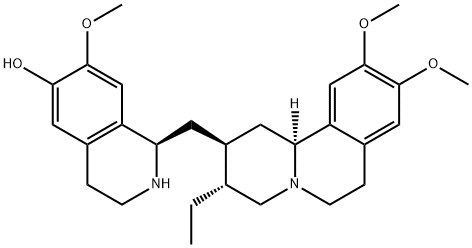- Cephaeline
-

- $129.00 / 1mg
-
2025-09-30
- CAS:483-17-0
- Min. Order:
- Purity: 99.45%
- Supply Ability: 10g
- cephaeline
-

- $2.00 / 1KG
-
2019-12-29
- CAS:483-17-0
- Min. Order: 1KG
- Purity: ≥98%
- Supply Ability: 20 tons
|
| | cephaeline Basic information |
| Product Name: | cephaeline | | Synonyms: | cephaeline;O-Phosphatidyl-ethanolamine;Cefalin;(-)-Cephaelin;(1R)-1-[[(2S,3R,11bS)-3-Ethyl-1,3,4,6,7,11b-hexahydro-9,10-dimethoxy-2H-benzo[a]quinolizin-2-yl]methyl]-1,2,3,4-tetrahydro-7-methoxy-6-isoquinolinol;7',10,11-Trimethoxyemetan-6'-ol;Cepheline;Desmethylemetine | | CAS: | 483-17-0 | | MF: | C28H38N2O4 | | MW: | 466.61 | | EINECS: | 207-591-6 | | Product Categories: | Chiral Reagents;Heterocycles;Intermediates & Fine Chemicals;Pharmaceuticals | | Mol File: | 483-17-0.mol |  |
| | cephaeline Chemical Properties |
| Melting point | 115-1160C | | alpha | D20 -43.4° (c = 2 in chloroform) | | Boiling point | 569.42°C (rough estimate) | | density | 1.21±0.1 g/cm3 (20 ºC 760 Torr) | | refractive index | 1.5800 (estimate) | | storage temp. | -20°C Freezer | | solubility | Acetonitrile: slightly soluble; Chloroform: slightly soluble; Ethanol: slightly soluble; Methanol: slightly soluble | | form | A crystalline solid | | pka | 9.90±0.40(Predicted) | | color | Light yellow to yellow | | Stability: | Hygroscopic |
| RIDADR | 1544 | | HazardClass | 6.1(b) | | PackingGroup | III |
| | cephaeline Usage And Synthesis |
| Chemical Properties | Crystalline Solid | | Uses | Cephaeline occurs in the ground roots ofipecac along with emetine. The Brazilian variety usually contains about 0.5%cephaeline. It is used as an emetic and anti amebic reagent. | | Uses | Has been used as an emetic and expectorant | | Definition | ChEBI: A pyridoisoquinoline comprising emetam having a hydroxy group at the 6'-position and methoxy substituents at the 7'-, 10- and 11-positions. | | Health Hazard | The toxicity of cephaeline is lower than thatof emetine. The toxic effects are cumula tive. Ingestion of high doses may producehypotension, muscle weakness, and gastroin testinal problems, including nausea, vomiting, and diarrhea. | | in vivo | Cephaeline (2 mg/kg, i.p.,daily for 3 days) suppresses ZIKV load and decreases the NS1 protein and ZIKV RNA in serum of ZIKV infected Ifnar1?/? mice[2].
Cephaeline (5 mg/kg, i.p.,daily for 7 days) effectively suppressed EBOV infection in EBOV mouse models[3].
Cephaeline (5, 10 mg/kg, i.p., a single dose for 12 days) plays an anti-lung cancer role by inducing ferroptosis in tumor xenograft mouse model[4].
| Animal Model: | Ifnar1?/? mice infected with ZIKV (8-9 week old, male and female)[2] | | Dosage: | 2 mg/kg | | Administration: | i.p.,daily for 3 days | | Result: | Significantly lowered the serum viral load of ZIKV infected Ifnar1?/? mice and decreased the NS1 protein and ZIKV RNA in serum and liver of mice, respectively. |
| Animal Model: | EBOV mouse model[3] | | Dosage: | 5 mg/kg | | Administration: | i.p., daily for 7 days | | Result: | Achieved 67% survival in EBOV infection to death in EBOV mouse model. |
| Animal Model: | Tumor xenograft mouse model injected with the lung cancer H460 cell line[4] | | Dosage: | 5, 10 mg/kg | | Administration: | i.p., a single dose for 12 days | | Result: | Showed significant antitumour effects in tumor xenograft mouse model. |
| | IC 50 | EBOV |
| | cephaeline Preparation Products And Raw materials |
| Raw materials | 6-Isoquinolinol, 1-[[(2S,3R,11bS)-3-ethyl-1,3,4,6,7,11b-hexahydro-9,10-dimethoxy-2H-benzo[a]quinolizin-2-yl]methyl]-1,2,3,4-tetrahydro-7-methoxy-, (1S)--->Ethanol |
|